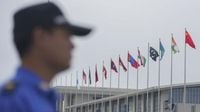Prime Minister Narendra Modi is embarking on a high-stakes diplomatic journey that could reshape India’s role in the shifting landscape of global power. On August 31, 2025, Modi will set foot in China for the first time since 2018, attending the Shanghai Cooperation Organisation (SCO) summit in the bustling port city of Tianjin. The summit, running through September 1, is more than just another entry on the diplomatic calendar—it comes at a moment of dramatic tension and transition for India’s foreign policy, especially as relations with the United States have recently soured.
Before landing in China, Modi spent two days in Japan, where he met with Prime Minister Shigeru Ishiba to discuss business, Japanese investment in India, and broader cooperation. But it is his next stop—China—that has captured international attention. Modi’s itinerary includes a bilateral meeting with Chinese President Xi Jinping and, notably, a sit-down with Russian President Vladimir Putin. The timing is anything but coincidental. Just days ago, President Donald Trump’s administration doubled tariffs on Indian exports to a whopping 50%, targeting around $60 billion in goods and rattling the foundation of what had been a steadily warming relationship between Delhi and Washington.
According to The Guardian, the tariff hike has left a deep mark on Indian policymakers and analysts alike. South Asia analyst Michael Kugelman summed up the prevailing mood: “Indian trust in the US is shattered.” The sense of betrayal is palpable, as years of strategic cooperation—fueled by shared concerns over Beijing’s growing influence—have been called into question. Washington’s rationale, as reported by Casablanca News, is India’s continued purchase of Russian oil. US trade adviser Peter Navarro went so far as to label India “an oil laundromat for the Kremlin,” accusing New Delhi of helping to finance Moscow’s war in Ukraine. India, for its part, has defended its Russian energy imports as essential for keeping domestic fuel prices stable and insists these purchases are within the bounds of international law. Modi has resisted direct condemnation of Moscow, instead calling for peace in Ukraine and emphasizing the need for dialogue and diplomacy.
Amid this diplomatic fallout, Modi’s visit to China is being widely interpreted as a symbol of thawing ties between Asia’s two giants. China has openly welcomed Modi’s arrival. Foreign ministry spokesperson Guo Jiakun described the upcoming SCO summit as entering “a new stage of high-quality development featuring greater solidarity, coordination, dynamism, and productiveness.” Guo added, “China welcomes Prime Minister Modi to China for the SCO Tianjin Summit.” The sentiment is echoed by both sides. Recent months have seen India and China resume issuing visas to each other’s citizens and agree to restart direct flights, paused since the Covid pandemic and the 2020 Galwan Valley border clash, beginning in September 2025.
The Galwan Valley clashes in 2020 marked a nadir in India-China relations, with tensions running high along the undemarcated border. However, as CNBC reported, a disengagement agreement was finalized in October 2020 at Demchok and Depsang, representing an important—if tentative—step toward de-escalation. The Indian Ministry of External Affairs has since outlined a strategy of resolving smaller border issues first, leaving more challenging conversations for another day. While no one expects the border dispute to be resolved overnight, the hope is that Modi and Xi’s meeting might spur further progress and build much-needed trust.
Strategic autonomy is a phrase that has come to define India’s foreign policy approach in recent years. Modi’s attendance at the SCO summit, sandwiched between meetings with leaders from China, Russia, and Japan, is a clear demonstration of India’s refusal to be boxed in by any one alliance. Despite pressure from the United States and the broader West to take sides over the Ukraine war, India has consistently advocated for a balanced approach. As The Guardian noted, “India has made it clear that it will do whatever it can to uphold the national interest and its strategic interests, including getting closer to Russia and a possible rapprochement with China.”
China, for its part, has been vocal in its opposition to the US tariffs imposed on India. Ambassador Xu Feihong was quoted on X (formerly Twitter) as saying, “Give the bully an inch, he will take a mile. China firmly opposes the tariff move and will firmly stand with India to uphold the multilateral trading system with the World Trade Organisation (WTO) at its core.” This sentiment was echoed by Chinese foreign ministry spokesperson Guo Jiakun, who declared, “China’s opposition to the abuse of tariffs is consistent and clear.”
Trade and economic cooperation will also be high on the agenda during Modi’s visit. India’s trade deficit with China has reached a staggering $99.2 billion in fiscal year 2024-2025, up from $85 billion the previous year. Imports from China hit an all-time high of $113.45 billion in 2025, according to data cited by CNBC. The Indian embassy in China expressed concern: “Our trade deficit concerns are two-pronged. One is the actual size of the deficit. Two is the fact that the imbalance has continuously been widening year after year. We continue to engage the Chinese side for addressing market access issues.”
There are signs that both nations are willing to take practical steps to address these imbalances. India is considering easing investment rules that have placed greater scrutiny on Chinese companies, while Beijing recently agreed to lift curbs on exports of fertilizers, rare earth minerals, and tunnel boring machines to India. At the same time, India’s ambition to have electric vehicles comprise six percent of all new cars sold by 2030 could be bolstered by Chinese expertise and technology, provided the two countries can find common ground.
India’s approach to economic diversification is clear. As access to the US market becomes more uncertain, New Delhi is reaching out to other major economies, including Japan and China, to cushion the blow. The loss of US market access will hit sectors such as textiles, jewelry, and other labor-intensive industries the hardest, but India’s top export destination remains the US, accounting for $86.5 billion annually—two-thirds of which is not subject to the new tariffs.
Experts are divided over the long-term implications of Modi’s diplomatic overture. Alyssa Ayres, adjunct senior fellow for India, Pakistan, and South Asia at the Council on Foreign Relations, observed, “They may very well term it a reset. I think even if they don’t, it looks like the global strategic affairs watchers are going to be terming this a reset, which may be as important to perceptions.” She added that cooperation on global governance and the Global South could be an area of shared interest, even as bilateral differences persist.
Manoj Kewalramani, head of Indo-Pacific studies at the Takshashila Institution in Bengaluru, told The Guardian, “An effort is underway to see if India and China can reach some sort of new equilibrium. Both recognize that the world order is in flux. Neither is likely to decisively manage all the frictions, but there’s at least a process of trying to grow the relationship.”
Yet skepticism remains. Amit Bhandari, senior fellow at Gateway House, cautioned, “The suspicion of China runs deep in India. It is unlikely that a Chinese partnership will become like the one India has with Russia or the US.”
As Modi prepares for his meetings in Tianjin, the world will be watching closely. The outcomes may not deliver dramatic breakthroughs, but even incremental gains in stability and predictability could mark a new chapter in the complex, ever-evolving relationship between India, China, and the broader international community.





